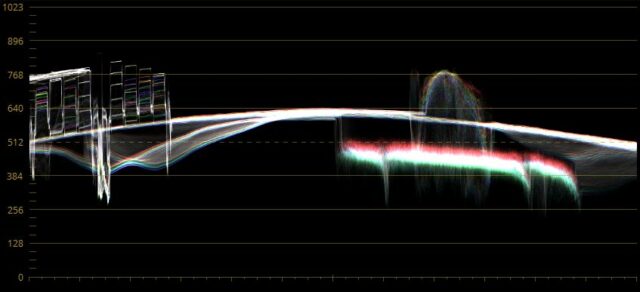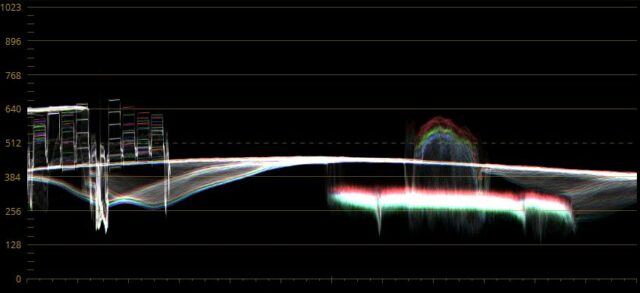RED V-RAPTOR 8K VV Lab Test: Rolling Shutter, Dynamic Range and Latitude – plus Video!
It’s been a while since the last RED camera was in the CineD headquarter, but now it’s that time again and the RED V-RAPTOR 8K VV is in our hands. I was really curious to run it through its paces in our standard lab test. Curious too? Then read on…
A lot of our readers have asked if we get a chance to test the RED V-RAPTOR 8K camera in our lab, especially after we tested the new ARRI ALEXA 35 (lab test here).
The RED V-RAPTOR specs are astonishing, with a 35.4 MP full frame CMOS Sensor (40,96 x 21,60 mm), 8K at 120 frames per second, and a claimed 17+ stops of dynamic range.
That sounds quite amazing, but as we all know there is no established standard to test the dynamic range for moving images (see our article and how we do our test here) – and that is why we have established our standard CineD Lab Test to shed some light on manufacturer’s claims!
So let’s have a look – it makes a lot of sense to read the article first and then watch the video, but that’s entirely up to you ;-).
Before getting started, we were letting the camera warm up for 20 minutes and then did a blackshading (calibration) of the sensor with the lens cap on (current camera firmware was 1.2.7). As usual, my dear colleague Florian Milz was helping me again with this lab test – thank you!
Rolling Shutter of the RED V-RAPTOR 8K VV
Using our standard method to measure rolling shutter with our strobe light, we get a solid 8ms (less is better) for the full frame 8K 17:9 DCI read out mode. This was to be expected, otherwise 120fps @8K wouldn’t be possible. This is among the best we have tested, only the SONY VENICE 2 had an even lower rolling shutter of 3ms (the ARRI ALEXA Mini LF has 7.4ms for example, test here).
In 6K Super 35 mode the rolling shutter reduces to 6ms, allowing 160fps image capture at that resolution. Those are top notch values.
Dynamic Range of the RED V-RAPTOR 8K VV
As usual we use our DSC Labs Xyla 21 stepchart to test dynamic range. There is no defined native ISO of the RED V-RAPTOR, and in REDCODE RAW the ISO can be set in post.
Looking at ISO800 8K REDCODE RAW HQ we get the following waveform:

Now, you might wonder what is going on here? Why did I not start to count the stops as usual, leaving out the second stop from the left? Well – this second stop from the left is reconstructed from clipped RGB channels – thats „highlight recovery“ which is built into RED’s IPP2 pipeline per default.
If you expand the RGB channels of the waveform you can see what is happening – the second stop (indicated with a red circle) does not show any RGB color information.

Only the third stop from the left has all 3 RGB channels, however the red channel is already at the cusp of clipping. Hence, we start to count dynamic range stops from the third patch.
Therefore, following our standard procedure (like we do with all cameras) we get to around 13 stops above the noise floor. Which is a very good result – for comparison, the ARRI ALEXA Mini LF (lab test here) exhibits only about one stop more (the ALEXA 35 has 3 stops more). The best full frame consumer cameras typically have around 12 stops to put things in perspective.
Now you might argue why I am not counting this „reconstructed“ stop? The answer is that it lacks all color information. If you scroll down to the latitude results, it becomes obvious what is meant here.
Looking at the IMATEST calculation, this default highlight recovery distorts the result as IMATEST also counts the not clipped, but reconstructed stop. IMATEST hence shows 13.4 stops at SNR = 2 and 14.9 stops at SNR = 1.
The same holds true for 4K full frame ProRes 4444 XQ. Quite interestingly, IMATEST results at ISO800 are very similar, 13.4 stops at SNR = 2 and 14.7 stops at SNR = 1. My expectation was that downscaling in-camera would improve dynamic range results.
To crosscheck, I also downscaled the 8K R3D image to 4K in DaVinci Resolve 18, and here I got slightly better values of 13.7 stops at SNR = 2 and 15.1 stops at SNR = 1.
Our current full frame benchmark for dynamic range is the ARRI ALEXA Mini LF with 13.5 stops at SNR = 2 and 14.7 stops for SNR = 1, without highlight recovery. The ARRI ALEXA 35 (Super 35 sensor) exhibits 15.1 and 16.3 stops at SNR = 2 and 1 respectively (also without highlight recovery).
Judging from the waveform and IMATEST results, I would say the RED V-RAPTOR has about 1 stop more dynamic range than the best consumer full frame cameras. Whereas the ALEXA Mini LF has about 1 stop more and the ALEXA 35 three stops more dynamic range than the RED V-RAPTOR.
Sidenote: with Blackmagic cameras, using BRAW you can select the option „highlight recovery“ in post (in DaVinci Resolve). I did a recent test with my BMPCC 6K and here the option „highlight recovery“ leads to about 1 stop higher IMATEST results at SNR = 2 and SNR = 1 compared to without HLR.
Latitude of the RED V-RAPTOR 8K VV
Again, everything was shot in REDCODE RAW HQ with the DaVinci Resolve development settings exhibited above (Full Res Premium) at ISO800.
Latitude is the capability of a camera to retain details and colors when over- or underexposed and pushed back to base exposure. Some time ago, we have chosen an arbitrary value of 60% luma value (in the waveform) for our subjects’ faces (actually the forehead) in our standard studio scene. This CineD base exposure should help our readers to get a reference point for all the cameras tested, regardless of how they distribute the code values and which LOG mode is used. Quite interestingly, the ALEXA Mini LF is symmetric around that base reference point of 60% luma value (it has a latitude of 5 stops above and 5 stops below that point).
For the V-RAPTOR the 60% luma value is already quite hot, and there are 2 additional stops in the highlights before the red channel on the forehead of my dear colleague Nino is starting to clip:
If we increase exposure beyond that, we are getting exactly into the region of the reconstructed stop (this was the second stop from the left in the waveform above):


You can see in the image above that all color information is lost on Nino’s forehead (and face), but there are still some image details visible – this is exactly what highlight recovery is doing.
It’s something very nice to have as it can save details in an overexposed shot to an extent. And you can identify it easily using RED’s stoplight exposure tools – as they are showing RAW sensor values.
In the example above, if exposure is increased beyond the 2 stops overexposed image, RED’s stoplights show the red channel starting to clip (as the RGB waveform does).
Now let’s have a look at underexposure. Closing down the iris to f/8 and from there onwards lowering the shutter angle to 90, 45, 22.5 degrees (and so on) we are getting very nice and clean images, and only at 6 stops of underexposure (below our base scene) some more serious noise is showing up:
We are already at 8 stops of exposure latitude, which is the max we can get out of full frame consumer cameras. Well, even the Sony VENICE 2 was already reaching it’s limits at that latitude in native 8.6K resolution (using the X-OCN XT codec). On a side note, the only consumer camera so far that was able to get close to 9 stops was the FUJIFILM X-H2S.
Noise reduction nicely cleans up that 6 stops underexposed and pushed up image:
Now, lets have a look at 7 stops of underexposure:
Noise reduction can still save that image, although we are getting a stronger brownish / pinkish cast (which is not so easy to remove):
We are already at 9 stops of exposure latitude! The best full frame camera so far, the ALEXA Mini LF was exhibiting a solid 10 stops. So lets see if we can pull that off with the RED V-RAPTOR:
Now, using even stronger noise reduction we can see that the image starts to fall apart – we are getting a very strong color cast, and in the darker sections of the image all details are corrupted:
It still looks surprisingly good however, especially because the noise is very finely distributed – but judge yourself.
Just to show you what happens at 9 stops of underexposure, pushed back:
This leads us to the final result: a solid 9 stops of exposure latitude with some wiggle room towards 10.
To mention the current benchmark for latitude, the ARRI ALEXA 35 shows 12 stops of exposure latitude in our standard CineD studio scene – 3 stops more, which can also be seen in the waveform and IMATEST result of that camera (lab test here).
Summary
The RED V-RAPTOR not only offers some impressive specs, it also exhibits a strong performance in our lab. Rolling shutter values are among the best (safe for the leader of the pack, the Sony VENICE 2), dynamic range and latitude results are strong and only fall short about 1 stop when compared to the ARRI Alexa Mini LF – our benchmark so far for full frame cine cameras.
All that in a package that is about half the cost of the Sony VENICE 2 or ARRI cameras. Impressive!
Of course you can also find the RED V-RAPTOR VV in our CineD database here.
Have you ever shot with the RED V-RAPTOR? What was your experience? Let us know your thoughts in the comment section below!














































